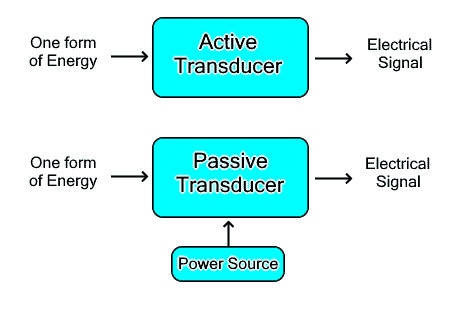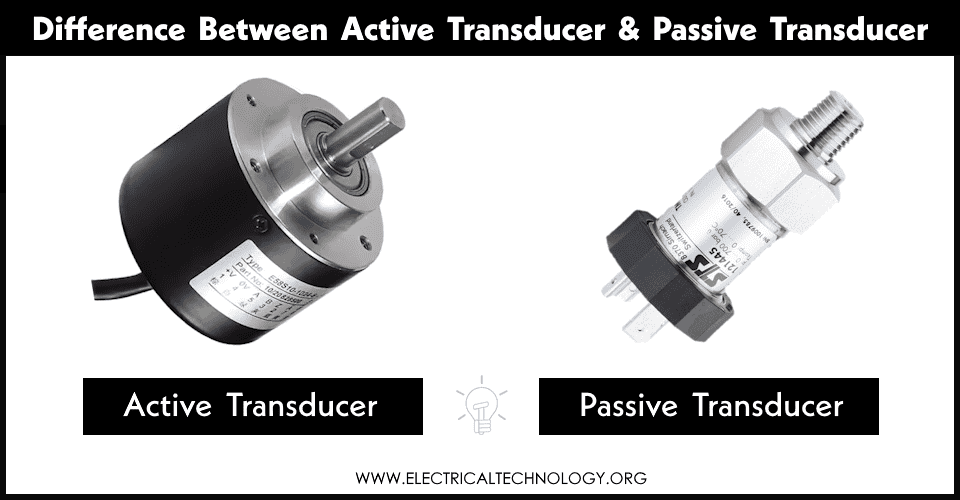Difference Between Active Transducer and Passive Transducer
What is the Main Differences Between Active and Passive Transducers
There are different kinds of physical quantities that cannot be easily measured using conventional tools. However, these quantities can be converted into other forms of energy that can be easily measured using other common tools. These sensors that convert such quantities are known as transducers. These transducers are readily available and used in instrumentation, control systems, robotics, automation, etc.
This article explains the differences between active and passive transducers but first, let’s explain some of its basics first.
What is a Transducer?
A transducer is an electrical device that converts a non-electrical quantity into an electrical quantity. The output signal is proportional to the input quantity. Its main purpose is to easily measure physical quantities such as pressure, temperature, light, etc.
There are different types of transducers and each of them works on different operating principles. However, it is mainly classified into two types that are active transducer and passive transducer.
- Related Post: Main Difference between Sensor and Transducer
Active Transducer
The active transducer is a type of transducer that does not require an external power source to convert a non-electrical quantity into an electrical one. It is also known as a self-generating transducer. It works on the principle of conversion of energy from one form into an electrical form.
Examples of active transducers are
- Thermocouple: A thermocouple converts the temperature into a voltage signal. It is made of two different metals having different thermoelectric properties which generates a potential difference proportional to heat.
- Photovoltaic: A photovoltaic cell converts light energy into an electrical current. It is made of a diode with an exposed junction where the current is generated with a strike of photon particles.
- Piezoelectric crystal: A piezoelectric crystal is an active transducer that converts the pressure being applied to it into a voltage signal. The magnitude of voltage is proportional to the applied pressure.
Related Post: Main Difference Between Sensor and Actuator
Passive Transducer
A passive transducer is a type of transducer that requires an external power source to convert non-electrical signals into electrical signals. They are also called externally powered transducers. Such transducer works by converting non-electrical quantities into electrical parameters such as resistance, capacitance and inductance, etc. These parameters are measured using an external power source to form a current and voltage signal.
- Resistive Transducer: such transducer works by varying its resistance with variation in the measuring quantity. Examples of resistive transducers are potentiometers, thermistors, etc. A potentiometer is used to measure displacement whereas a thermistor is used to measure temperature.
- Capacitive Transducer: in such a transducer, the capacitance varies with the change in physical quantity. Examples are pressure and humidity measurements. The change in pressure can vary the gap in-between plates causing to vary the capacitance. The humidity also varies the capacitance.
- Inductive Transducer: the inductance of such transducer varies with changes in non-electrical quantities. Examples are proximity sensors and metal detectors. The physical motion varies the inductance of a coil.
- Related Post: Difference between RTD and Thermocouple
Differences Between Active Transducer & Passive Transducer
The following table shows the comparisons between Active and Passive Transducers.
| Active Transducer | Passive Transducer |
| An active transducer converts non-electrical quantity into electrical energy without using an external power source. | Passive transducers convert non-electrical quantities into electrical quantities using an external power source. |
| It is also known as a self-generating transducer | It is also known as an externally powered transducer |
| It draws energy from the measuring source. | It draws energy from external power sources. |
| It has a very simple design. | It has a relatively complex design. |
| The amplitude of the output signal is very low. | The output signal’s amplitude depends on the external source. |
| Its output signal needs further amplification | Its output signal does not need amplification |
| Its output signal is in the form of current or voltage. | Its output is in the form of passive electrical parameters such as resistance, inductance and capacitance. |
| The smallest input changes produce very small changes in output. Therefore It has a very low resolution. | It can easily detect very small changes in input because of external power sources. Thus It has a high resolution |
| The resolution is fixed and cannot be adjusted because the output depends only on the input signal. | The resolution can be adjusted varying the external power supply. |
| Active transducers are inexpensive and economical. | Passive transducers are expensive. |
| Examples of active transducers are piezoelectric crystals, photovoltaic cells, thermocouples, etc. | Examples of passive transducers are potentiometers, thermistors, variable capacitors and LVDT, etc. |
- Related Post: Difference Between Thermistor and Thermocouple
Comparison Between Active and Passive Transducers
Power Source
One of the key differences between active and passive transducers is the external power source. Active transducer does not require an external power source while passive transducers do.
Output
The output of the active transducer is in the form of a voltage or current signal. While the output of the passive transducer is in the form of a change in resistance, capacitance and inductance.
Resolution
The active transducer has low resolution and it is less sensitive to small changes. While passive transducer has high resolution and more sensitive to small changes due to external sources. The resolution is also adjustable by varying the external source.
Amplifier
The active transducer generates a very low power signal thus it requires an amplifier while the passive transducer does not require an amplifier.
Design
Active transducers have a very simple design and construction. While passive transducers are very complex to design and manufacture.
Cost
Active transducers are inexpensive and very economical due to their simple design. While passive transducers are expensive.
Examples
- Active transducers are thermocouples, piezoelectric crystals, photovoltaic cells, tachogenerator, etc.
- Passive transducers are potentiometers, thermistors, variable capacitors, etc.
Related posts about the comparison and differences between different electrical and electronic components and devices.
- Difference Between Microprocessor and Microcontroller
- Difference between Analog and Digital Circuit – Digital vs Analog
- Difference between Inverter & UPS – Uninterruptible Power Supply
- Difference Between Online UPS and Offline UPS – Which One is Better?
- Difference between Voltage Source Inverter & Current Source Inverter
- Difference Between Encoder and Decoder
- Difference Between BJT and FET Transistors
- Difference Between NPN and PNP Transistor
- Difference between Active and Passive Components
- Difference Between Active Transducer and Passive Transducer
- Difference Between Multiplexer (MUX) & Demultiplexer (DEMUX)
- Difference Between Edge Triggering and Level Triggering
- Difference Between Serial and Parallel Communication








